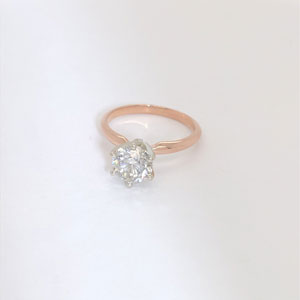Metals for Engagement Rings
Gold
Gold is a rare metal that will not tarnish or rust when worn. Gold has a unique shine and luster that has attracted so many people in all cultures through time. Because of its malleable nature, it has been used in electronics, medical applications, and of course, jewelry. Gold use in jewelry usually depends on the culture or its use. Gold in its 24k purest state is too soft to set diamonds and gemstones.
Many countries will make gold into 20 - 22k and apply colorful enamels. When setting diamonds or gemstones it is more common to add alloy to change its color and strengthen the gold. Gold that has alloy added to it is now referred by its purity level. Gold is broken down into 24 parts. Pure gold is 24 karat. If the jewelry is 75% pure gold, it is then referred as 18kt. If the jewelry is 58.3% pure gold, it is then referred as 14kt. If the jewelry is 41.8% pure gold, then it is referred as 10kt.
Gold jewelry is available in multiple colors and combinations. Gold has allowed designers to make designs in cool tones with white gold, warm tones in yellow gold, and an exotic look in rose gold. The making of these different colors of gold has reintroduced more gemstones and colored diamonds back into more designs:
Rose Gold
Rose gold has come on strong with the use of brown and reddish colored diamonds. Although 18 karat rose gold is available rose gold is usually made in 14kt. Many jewelers find 10 and 18 karat rose gold harder to work with than 14 karat rose gold.
White Gold
White gold has changed formulas over the years to try and find a way to stay white without the need of being whitened or plated in rhodium. In order to make white gold, nickel, silver and other alloys has been added to yellow gold. Since nickel is not hypoallergenic, the industry has been trying to find the magic formula to make a white gold that jewelers can easily use and is hypoallergenic.
White gold is a flexible choice for consumer's budgets. White gold is cost effective and very durable in 10 and 14 karat. In 18 karat, white gold is softer and more durable than 10 and 14 karat, but is still resilient enough for most style in fine jewelry. White gold is found to have the best combination of metal value, wear durability and cost effectiveness, therefore white gold has found a permanent place in the fine jewelry industry.
Yellow Gold
Yellow gold has been the go-to metal for many industries besides jewelry. As you are reading this, yellow gold wire is making connections throughout your electronic device at lightning speed. Museums are filled with yellow gold jewelry from ancient cultures. Yellow gold jewelry has been handed down through the generations. Making yellow gold more durable to wear to last is not new. 24 karat yellow gold is great for some industries but it is too soft for diamonds and gemstones.
Consumers can choose among 10, 14 or 18 karat to meet their jewelry needs. In the United States, 10 karat yellow gold is used for cost effectiveness and durability. The 18 karat yellow gold is used when gold purity matters, still being durable enough for most fine jewelry designs. 14 karat yellow gold still has the rich yellow tone, durable feel, and cost effectiveness that fine jewelry consumers are wanting.
Platinum
Platinum is a rarest of the white metals used in fine jewelry. In fact, platinum is 30 times rarer than gold. Platinum will not tarnish or change color over time and does not need to be whitened after it has been worked on by a jeweler. When wearing a platinum ring, it's very obvious how heavy it feels, since platinum is 60% heavier than gold. When making fine jewelry in platinum, 90-95% pure platinum will be used. Unlike gold, where as little as 41%, 58% or 75% pure gold will be used.
Palladium
Because gold is not found naturally in white, platinum and silver have been used as its white metal in fine jewelry for many years. However, silver is not as conducive to fine jewelry as platinum and platinum can be more expensive. Looking for a cost effective pure white metal that is tarnish resistant and easy to work with has been difficult. That is why yellow gold has been converted to 'almost' white gold for years.
As far back as the late 1930s, jewelers used palladium in fine jewelry. Jewelers were glad to have a metal that is pure white and less expensive than platinum, but jewelers found it harder to work with than gold. Today, jewelers have better technology to help them work the palladium. However, palladium has not been able to replace the sentiment, tradition or institution that gold has been in wedding proposals or heirloom jewelry.


